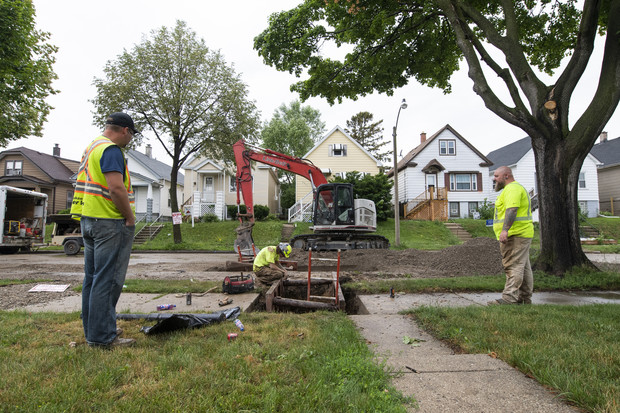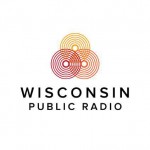State Could Get $800 Million For Water Systems
Federal infrastructure bill could help pay for replacing lead pipes, upgrading sewer systems and more.

From left: Tom Iglinski, Jericho Gomez and Ryan DeBelak are part of a four-person crew working to replace a lead water service pipeline in Milwaukee on June 29, 2021. Wisconsin communities have replaced more than 115,000 utility-owned and privately-owned service line portions since 2016, according to a Wisconsin Watch analysis. Still lurking in 2020, however: an estimated 465,000 pipeline portions made of lead or other potentially hazardous materials. Isaac Wasserman/Wisconsin Watch
Wisconsin’s aging water and wastewater systems may be able to speed up improvements with more than $800 million the state is set to receive through the $1 trillion infrastructure bill recently passed by the U.S. House. The infusion of federal dollars marks a historic investment, but it represents a fraction of the overall need statewide.
The bill devotes $55 billion to upgrading water and wastewater infrastructure nationwide, and the legislation sets aside $15 billion to replace lead pipes. Wisconsin is expected to see $841 million over the next five years to improve water infrastructure based on an existing funding formula for the state’s revolving loan funds.
The bill will help Wisconsin communities make progress on long overdue water upgrades, but it would take roughly 10 times that amount to improve drinking water systems alone statewide.
Around $8.6 billion is needed to improve Wisconsin’s more than 11,000 public water supplies over the next two decades, according to the American Society of Civil Engineers. Wastewater systems report nearly $6.3 billion worth of investment that’s needed to address aging infrastructure.
Chris Groh, executive director of the Wisconsin Rural Water Association, said the funding may help ease the pain for customers who are currently paying for upgrades through increases in water and sewer rates. He said many of the smaller communities they represent with 10,000 or fewer customers have systems that are more than 50 years old.
“We have sewer mains that are old, or they collapse. We have water lines that will crack in the winters and leak water out,” said Groh.
Groh added those systems often encounter lead service lines to the home. Wisconsin has replaced more than 115,000 lead lines since 2016, according to Wisconsin Watch. The investigative news outlet’s analysis found about 465,000 pipeline segments containing lead or other harmful materials still need to be removed.
“We’re excited that the bi-partisan infrastructure bill provides significant funding to improve water infrastructure and will allow us to accelerate our efforts to replace lead service lines across the City of Milwaukee,” said Dettmer.
But advocates for replacing lead lines in Milwaukee have voiced frustration with the city’s efforts to remove lead pipes. Since 2017, the city has been replacing 1,000 lead lines or less each year. At that rate, it will take more than 70 years to remove the city’s remaining lead pipes.
“It just feels very backburner to me,” said Derek Beyer, steering committee member with Milwaukee’s Get The Lead Out Coalition. “When you consider there’s human beings, especially kids, unknowingly, being harmed by this, it’s outrageous.”
Milwaukee Water Works budgeted $13.4 million for lead line replacements in 2020 – an increase over previous years. Officials highlighted challenges with removing lines during the COVID-19 pandemic, and they’ve pointed to financial constraints with addressing lead lines.
Children are more vulnerable to lead poisoning, which can cause developmental issues among other health problems. Lead pipes are the most common source of lead in drinking water. Children can also be exposed to lead through lead-based paint and other lead-based products.
A report released in 2019 by Wisconsin Environment and the WISPIRG Foundation gave the state a failing grade for not preventing lead in school drinking water. Last year, the U.S. Environmental Protection Agency updated its decades-old lead and copper rule to require public water supplies to test drinking water at schools and day care centers, as well as map all their lead service lines.
“When we’re talking about kids and schools, you know, really the only way to ensure safe drinking water is to get the lead out of them entirely,” said Megan Severson, state director for Wisconsin Environment. “We need the federal infusion of funding to just remove the lead service lines and to tackle all of the components in the schools.”
She added that President Biden’s administration would provide additional funding to address lead pipes as part of the Build Back Better legislation still being debated in Congress. The scaled back nearly $2 trillion reconciliation package would include another $9 billion for lead reduction. Industry and environmental advocates have estimated it would cost $60 billion to replace the nation’s six to 10 million lead lines.
Other funding Wisconsin is estimated to receive under the $1 trillion infrastructure bill:
- $5.2 billion for federal-aid highway programs over five years.
- $225 million for bridge replacement over five years.
- $592 million for public transit over five years.
- $79 million to support electric vehicle charging stations over five years.
- $100 million to expand broadband internet.
- $20 million to protect against wildfires over five years.
- $18 million to protect against cyberattacks over five years.
- $198 million for infrastructure development at airports over five years.
Listen to the WPR report here.
Wisconsin may get more than $800M to upgrade water systems under the $1T infrastructure bill was originally published by Wisconsin Public Radio.
More about the Lead Crisis
- EPA Announces $3 Billion in New Funding for States to Reduce Lead in Drinking Water - U.S. Environmental Protection Agency - Nov 25th, 2025
- Wisconsin Communities Get $282 Million for Drinking Water Projects - Danielle Kaeding - Nov 19th, 2025
- MKE County: County Launches Lead Abatement Program - Graham Kilmer - Nov 9th, 2025
- Milwaukee County Launches Lead Remediation Program to Reduce Lead-Based Paint Hazards in Homes in Suburban Communities - David Crowley - Nov 5th, 2025
- Wisconsin Improves Child Lead Testing Rates, Urges Continued Testing and At-Home Prevention - Wisconsin Department of Health Services - Oct 21st, 2025
- City Hall: Milwaukee Must Replace 100 Lead Laterals Per Week To Meet 2025 Goal - Jeramey Jannene - Oct 1st, 2025
- MPS Clears Lead Risks from all Pre-1950 Elementary Buildings - Milwaukee Public Schools - Sep 5th, 2025
- MPS Issues Update on Lead Remediation Progress as New School Year Nears - Milwaukee Public Schools - Jul 31st, 2025
- Gov. Evers Approves Bill to Support Lead Service Line Replacement in Superior - Gov. Tony Evers - Jul 1st, 2025
- MPS’s Westside Academy Cleared of Lead Risks After Stabilization Work - Milwaukee Public Schools - Jul 1st, 2025
Read more about Lead Crisis here




















